
Cultivated plant taxonomy
Encyclopedia
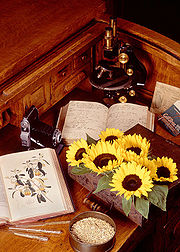
Theory
The English word theory was derived from a technical term in Ancient Greek philosophy. The word theoria, , meant "a looking at, viewing, beholding", and referring to contemplation or speculation, as opposed to action...
and practice of the science
Science
Science is a systematic enterprise that builds and organizes knowledge in the form of testable explanations and predictions about the universe...
that identifies, describes, classifies, and names cultigen
Cultigen
A cultigen is a plant that has been deliberately altered or selected by humans; it is the result of artificial selection. These "man-made" or anthropogenic plants are, for the most part, plants of commerce that are used in horticulture, agriculture and forestry...
s—those plants whose origin or selection is primarily due to intentional human activity. Cultivated plant taxonomists do, however, work with all kinds of plants in cultivation.
Cultivated plant taxonomy is one part of the study of horticultural botany
Horticultural botany
Horticultural botany is the study of the botany of current and potential cultivated plants, with emphasis on the ornamental plants of horticulture, by a horticultural botanist or plantsman—plantsperson."-Horticultural botanists:...
which is mostly carried out in botanical garden
Botanical garden
A botanical garden The terms botanic and botanical, and garden or gardens are used more-or-less interchangeably, although the word botanic is generally reserved for the earlier, more traditional gardens. is a well-tended area displaying a wide range of plants labelled with their botanical names...
s, large nurseries, universities, or government departments. Areas of special interest for the cultivated plant taxonomist include: searching for and recording new plants suitable for cultivation (plant hunting
Plant collecting
Plant collecting involves procuring live or dried plant specimens, for the purposes of research, cultivation or as a hobby.-Collection of live specimens:...
); communicating with and advising the general public on matters concerning the classification
Biological classification
Biological classification, or scientific classification in biology, is a method to group and categorize organisms by biological type, such as genus or species. Biological classification is part of scientific taxonomy....
and nomenclature of cultivated plants and carrying out original research on these topics; describing the cultivated plants of particular regions (horticultural flora
Horticultural flora
A horticultural flora, also known as a garden flora, is a plant identification aid structured in the same way as a native plants flora. It servies the same purpose to facilitate plant identification, however it only includes plants that are under cultivation as ornamental plants growing within the...
s); maintaining databases, herbaria
Herbarium
In botany, a herbarium – sometimes known by the Anglicized term herbar – is a collection of preserved plant specimens. These specimens may be whole plants or plant parts: these will usually be in a dried form, mounted on a sheet, but depending upon the material may also be kept in...
and other information about cultivated plants.
Much of the work of the cultivated plant taxonomist is concerned with the naming of plants as prescribed by two plant nomenclatural Codes. The provisions of the International Code of Botanical Nomenclature (Botanical Code) serve primarily scientific ends and the objectives of the scientific community, while those of the International Code of Nomenclature for Cultivated Plants
International Code of Nomenclature for Cultivated Plants
The International Code of Nomenclature for Cultivated Plants regulates the names of cultigens...
(Cultivated Plant Code) are designed to serve both scientific and utilitarian ends by making provision for the names of plants used in commerce — the cultigens that have arisen in agriculture, forestry and horticulture. These names, sometimes called variety names, are not in Latin but are added onto the scientific Latin names, and they assist communication among the community of foresters, farmers and horticulturists.
The history of cultivated plant taxonomy can be traced from the first plant selections that occurred during the agrarian Neolithic Revolution
Neolithic Revolution
The Neolithic Revolution was the first agricultural revolution. It was the transition from hunting and gathering to agriculture and settlement. Archaeological data indicates that various forms of plants and animal domestication evolved independently in 6 separate locations worldwide circa...
to the first recorded naming of human plant selections by the Romans. The naming and classification of cultigens followed a similar path to that of all plants until the establishment of the first Cultivated Plant Code in 1953 which formally established the cultigen classification category of cultivar. Since that time the classification and naming of cultigens has followed its own path.
Distinctive characteristics of cultivated plant taxonomy
Cultivated plant taxonomyTaxonomy
Taxonomy is the science of identifying and naming species, and arranging them into a classification. The field of taxonomy, sometimes referred to as "biological taxonomy", revolves around the description and use of taxonomic units, known as taxa...
has been distinguished from the taxonomy of other plants in at least five ways. Firstly, there is a distinction made according to where the plants are growing — that is, whether they are wild or cultivated. This is alluded to by the Cultivated Plant Code which specifies in its title that it is dealing with cultivated plants. Secondly, a distinction is made according to how the plants originated. This is indicated in Principle 2 of the Cultivated Plant Code which defines the scope of the Code as "... plants whose origin or selection is primarily due to the intentional actions of mankind" — plants that have evolved under natural selection with human assistance.Thirdly, cultivated plant taxonomy is concerned with plant variation that requires the use of special classification categories that do not conform with the hierarchy of ranks implicit in the Botanical Code, these categories being the cultivar
Cultivar
A cultivar'Cultivar has two meanings as explained under Formal definition. When used in reference to a taxon, the word does not apply to an individual plant but to all those plants sharing the unique characteristics that define the cultivar. is a plant or group of plants selected for desirable...
, Group
Cultivar group
In naming cultivated plants, a Group is a formal classification category, under the International Code of Nomenclature for Cultivated Plants :The term "Group" was introduced in the 2004 ICNCP, replacing the "Cultivar-group" of the 1995 ICNCP.A Group is united by some common trait; for example...
and grex
Grex (horticulture)
The term grex , derived from the Latin noun grex, gregis meaning flock, has been coined to expand botanical nomenclature to describe horticultural hybrids of orchids, based solely on their specified parentage...
(which are only loosely equivalent to ranks in the Botanical Code). This feature is also referred to in the Preamble to the Cultivated Plant Code which states that "The purpose of giving a name to a taxon is not to indicate its characters or history, but to supply a means of referring to it and to indicate to which category it is assigned." Fourthly, cultivated plant taxonomy serves a particular community of people: the Botanical Code focuses on the needs of plant taxonomists as they attempt to maintain order and stability for the scientific names of all plants, while the Cultivated Plant Code caters for the needs of people requiring names for plants used in the commercial world of agriculture, forestry and horticulture. Finally, the difference between cultivated plant taxonomy and the taxonomy of other plants has been attributed to the purpose for which the taxonomy has been devised, it being plant-centred in the Botanical Code and human-centred in the Cultivated Plant Code.
Scientific and anthropocentric classification

Taxonomy
Taxonomy is the science of identifying and naming species, and arranging them into a classification. The field of taxonomy, sometimes referred to as "biological taxonomy", revolves around the description and use of taxonomic units, known as taxa...
) and naming (nomenclature
Nomenclature
Nomenclature is a term that applies to either a list of names or terms, or to the system of principles, procedures and terms related to naming - which is the assigning of a word or phrase to a particular object or property...
). The rules associated with naming plants are separate from the methods, principles or purposes of classification, except that the units of classification, the taxa, are placed in a nested hierarchy
Hierarchy
A hierarchy is an arrangement of items in which the items are represented as being "above," "below," or "at the same level as" one another...
of rank
Taxonomic rank
In biological classification, rank is the level in a taxonomic hierarchy. Examples of taxonomic ranks are species, genus, family, and class. Each rank subsumes under it a number of less general categories...
s – like species within genera, and genera within families. There are three classification categories used in the Cultivated Plant Code, the cultivar
Cultivar
A cultivar'Cultivar has two meanings as explained under Formal definition. When used in reference to a taxon, the word does not apply to an individual plant but to all those plants sharing the unique characteristics that define the cultivar. is a plant or group of plants selected for desirable...
and the Group
Cultivar group
In naming cultivated plants, a Group is a formal classification category, under the International Code of Nomenclature for Cultivated Plants :The term "Group" was introduced in the 2004 ICNCP, replacing the "Cultivar-group" of the 1995 ICNCP.A Group is united by some common trait; for example...
and the grex
Grex (horticulture)
The term grex , derived from the Latin noun grex, gregis meaning flock, has been coined to expand botanical nomenclature to describe horticultural hybrids of orchids, based solely on their specified parentage...
, but they are only loosely equivalent to ranks in the Botanical Code.
From the time of the ancient world, at least, plants have been classified in two ways. On the one hand there is the detached academic, philosophical or scientific interest in plants themselves: this groups plants by their relationship to one-another according to their similarities and differences in structure and function. Then there is the practical, utilitarian or anthropocentric interest which groups plants according to their human use. Cultivated plant taxonomy is concerned with the special classification categories needed for the plants of agriculture, horticulture and forestry as regulated by the Cultivated Plant Code. This Code serves not only the scientific interests of formal nomenclature, it also caters for the special utilitarian needs of people dealing with the plants of commerce. Those cultigens given names governed by the Cultivated Plant Code fulfill three criteria: they have special features considered of sufficient importance to warrant a name; the special features are the result of deliberate human breeding or selection and are not found in wild populations (except in rare cases where the special features represent desirable part of natural variation found in wild populations that is not covered by a scientific name); it is possible to perpetuate the desirable features by propagation in cultivation.
The terms cultigen and cultivar may be confused with each other. Cultigen is a general-purpose term for plants that have been deliberately altered or specially selected by humans, while cultivar is a formal classification category. Cultigens include not only plants with cultivar names but also those with names in the classification categories of grex and Group. The Cultivated Plant Code points out that cultigens are: deliberately selected plants that may have arisen by intentional or accidental hybridization in cultivation, by selection from existing cultivated stocks, or from variants within wild populations that are maintained as recognizable entities solely by continued propagation. Included within the group of plants known as cultigens are genetically modified
Genetically modified organism
A genetically modified organism or genetically engineered organism is an organism whose genetic material has been altered using genetic engineering techniques. These techniques, generally known as recombinant DNA technology, use DNA molecules from different sources, which are combined into one...
plants, plants with binomial Latin names that are the result of ancient human selection, and any plants that have been altered by humans but which have not been given formal names. In practice most cultigens are cultivars.
The following account of the historical development of cultivated plant taxonomy traces the way cultigens have arisen and been incorporated into botanical science; it also demonstrates how two approaches to plant nomenclature and classification have led to the present-day International Code of Botanical Nomenclature and International Code of Nomenclature for Cultivated Plants.
Historical development of cultivated plant taxonomy
The history of cultigen nomenclature has been discussed by William T. StearnWilliam T. Stearn
William Thomas Stearn CBE was a British botanist known for his expertise on the history of botany and in the classical languages. His work is widely read, with his etymological dictionary of Latin names of garden plants likely the best-known of the works appearing under his own name...
and Brandenberg, Hetterscheid and Berg. It has also been examined from a botanical perspective and from the origin of the Cultivated Plant Code in 1953 until 2004.
The early development of cultigen taxonomy follows that of plant taxonomy in general as the early listing and documentation of plants made little distinction between those that were anthropogenic and those that were natural wild kinds. Formal botanical nomenclature
Botanical nomenclature
Botanical nomenclature is the formal, scientific naming of plants. It is related to, but distinct from taxonomy. Plant taxonomy is concerned with grouping and classifying plants; botanical nomenclature then provides names for the results of this process. The starting point for modern botanical...
and classification evolved from the simple binomial
Binomial nomenclature
Binomial nomenclature is a formal system of naming species of living things by giving each a name composed of two parts, both of which use Latin grammatical forms, although they can be based on words from other languages...
system of folk taxonomy
Folk taxonomy
A folk taxonomy is a vernacular naming system, and can be contrasted with scientific taxonomy. Folk biological classification is the way peoples describe and organize their natural surroundings/the world around them, typically making generous use of form taxa like "shrubs", "bugs", "ducks",...
and it was not until the mid-19th century that the nomenclatural path of cultigens began to diverge from mainstream plant taxonomy.
10,000 to 400 BCE – plant domestication
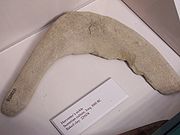
Cultigens of our most common economic plants probably date back to the first settled communities of the Neolithic Revolution
Neolithic Revolution
The Neolithic Revolution was the first agricultural revolution. It was the transition from hunting and gathering to agriculture and settlement. Archaeological data indicates that various forms of plants and animal domestication evolved independently in 6 separate locations worldwide circa...
10,000 to 12,000 years ago although their exact time and place of true origin will probably remain a mystery. In the Western world among the first cultigens would have been selections of the cereals wheat
Wheat
Wheat is a cereal grain, originally from the Levant region of the Near East, but now cultivated worldwide. In 2007 world production of wheat was 607 million tons, making it the third most-produced cereal after maize and rice...
and barley
Barley
Barley is a major cereal grain, a member of the grass family. It serves as a major animal fodder, as a base malt for beer and certain distilled beverages, and as a component of various health foods...
that arose in the early settlements of the Fertile Crescent
Fertile Crescent
The Fertile Crescent, nicknamed "The Cradle of Civilization" for the fact the first civilizations started there, is a crescent-shaped region containing the comparatively moist and fertile land of otherwise arid and semi-arid Western Asia. The term was first used by University of Chicago...
(the fertile river valleys of the Nile, Tigris and Euphrates) in the Western Mediterranean. Food plant selections would also have been made in the ten or so other centres of settlement that occurred around the world at this time. Confining crops to local areas gave rise to landrace
Landrace
A landrace is a local variety of a domesticated animal or plant species which has developed largely by natural processes, by adaptation to the natural and cultural environment in which it lives. It differs from a formal breed which has been bred deliberately to conform to a particular standard...
s (selections that are highly adapted to local conditions) although these are now largely replaced by modern cultivars. Cuttings are an extremely effective way of perpetuating desirable characters, especially of woody plants like grape
Grape
A grape is a non-climacteric fruit, specifically a berry, that grows on the perennial and deciduous woody vines of the genus Vitis. Grapes can be eaten raw or they can be used for making jam, juice, jelly, vinegar, wine, grape seed extracts, raisins, molasses and grape seed oil. Grapes are also...
s, fig
Ficus
Ficus is a genus of about 850 species of woody trees, shrubs, vines, epiphytes, and hemiepiphyte in the family Moraceae. Collectively known as fig trees or figs, they are native throughout the tropics with a few species extending into the semi-warm temperate zone. The Common Fig Ficus is a genus of...
s and olive
Olive
The olive , Olea europaea), is a species of a small tree in the family Oleaceae, native to the coastal areas of the eastern Mediterranean Basin as well as northern Iran at the south end of the Caspian Sea.Its fruit, also called the olive, is of major agricultural importance in the...
s so it is not surprising that these are among the first known plant selections perpetuated in cultivation in the West. Migrating people would take their plant seeds and cuttings with them; there is evidence of early Fertile Crescent cereal cultigens being transferred from Western Asia to surrounding lands.
400 BCE to 1400 – the ancient world: Greco-Roman influence to the Middle Ages

Hippo (philosopher)
Hippo was a Presocratic Greek philosopher. He is variously described as coming from Rhegium, Metapontum, Samos, and Croton, and it is possible that there was more than one philosopher with this name....
expressed the opinion that cultigens (as we call them now) were produced from wild plants as the result of the care bestowed on them by man, a revolutionary view at a time when they were regarded as the special creation and gift of the gods. In devising ways of classifying organisms the philosopher Aristotle
Aristotle
Aristotle was a Greek philosopher and polymath, a student of Plato and teacher of Alexander the Great. His writings cover many subjects, including physics, metaphysics, poetry, theater, music, logic, rhetoric, linguistics, politics, government, ethics, biology, and zoology...
(384–322 BCE) established the important idea of a fundamentum divisionis — the principle that groups can be progressively subdivided. This has been assumed in biological classification
Biological classification
Biological classification, or scientific classification in biology, is a method to group and categorize organisms by biological type, such as genus or species. Biological classification is part of scientific taxonomy....
ever since and is congruent with the relatively recent idea of evolution as descent with modification. All biological classification follows this principle of groups within groups, known as a nested hierarchy
Hierarchy
A hierarchy is an arrangement of items in which the items are represented as being "above," "below," or "at the same level as" one another...
, but this form of classification does not necessarily presuppose evolution.

Theophrastus
Theophrastus , a Greek native of Eresos in Lesbos, was the successor to Aristotle in the Peripatetic school. He came to Athens at a young age, and initially studied in Plato's school. After Plato's death he attached himself to Aristotle. Aristotle bequeathed to Theophrastus his writings, and...
(371–286 BCE), known as the "father of botany". In his Enquiry into Plants Theophrastus described 480 kinds of plant, dividing the plant kingdom into tree
Tree
A tree is a perennial woody plant. It is most often defined as a woody plant that has many secondary branches supported clear of the ground on a single main stem or trunk with clear apical dominance. A minimum height specification at maturity is cited by some authors, varying from 3 m to...
s, shrub
Shrub
A shrub or bush is distinguished from a tree by its multiple stems and shorter height, usually under 5–6 m tall. A large number of plants may become either shrubs or trees, depending on the growing conditions they experience...
s, undershrubs and herb
Herb
Except in botanical usage, an herb is "any plant with leaves, seeds, or flowers used for flavoring, food, medicine, or perfume" or "a part of such a plant as used in cooking"...
s with further subdivision into wild
Wildlife
Wildlife includes all non-domesticated plants, animals and other organisms. Domesticating wild plant and animal species for human benefit has occurred many times all over the planet, and has a major impact on the environment, both positive and negative....
and cultivated
Horticulture
Horticulture is the industry and science of plant cultivation including the process of preparing soil for the planting of seeds, tubers, or cuttings. Horticulturists work and conduct research in the disciplines of plant propagation and cultivation, crop production, plant breeding and genetic...
, flowering and non-flowering, deciduous
Deciduous
Deciduous means "falling off at maturity" or "tending to fall off", and is typically used in reference to trees or shrubs that lose their leaves seasonally, and to the shedding of other plant structures such as petals after flowering or fruit when ripe...
or evergreen
Evergreen
In botany, an evergreen plant is a plant that has leaves in all seasons. This contrasts with deciduous plants, which completely lose their foliage during the winter or dry season.There are many different kinds of evergreen plants, both trees and shrubs...
.
The utilitarian approach, classifying plants according to their medicinal properties, is exemplified by the work of Roman nobleman, scientist and historian, Pliny the Elder
Pliny the Elder
Gaius Plinius Secundus , better known as Pliny the Elder, was a Roman author, naturalist, and natural philosopher, as well as naval and army commander of the early Roman Empire, and personal friend of the emperor Vespasian...
(29–79 CE) author of Naturalis historiae. “Cultivars” listed here are named after people, places or special plant characteristics. Most notable is the work of Dioscorides (ca.40–ca.90 CE) a Greek doctor who worked with the Roman army. His five-volume Materia Medica was a forerunner of the herbal
Herbal
AThe use of a or an depends on whether or not herbal is pronounced with a silent h. herbal is "a collection of descriptions of plants put together for medicinal purposes." Expressed more elaborately — it is a book containing the names and descriptions of plants, usually with information on their...
which led to the modern pharmacopoeia
Pharmacopoeia
Pharmacopoeia, pharmacopeia, or pharmacopoea, , in its modern technical sense, is a book containing directions for the identification of samples and the preparation of compound medicines, and published by the authority of a government or a medical or pharmaceutical society.In a broader sense it is...
. This work was endlessly plagiarised by later herbals including those printed between about 1470 and 1670 CE: it listed 600 to 1000 different kinds of plants including the cultigens Gallica
Rosa gallica
Rosa gallica is a species of rose native to southern and central Europe eastwards to Turkey and the Caucasus....
, Centifolia
Rosa centifolia
Rosa × centifolia , the provence rose or cabbage rose or Rose de Mai is a hybrid rose developed by Dutch rose breeders in the period between the 17th century and the 19th century, possibly earlier...
, the rose of uncertain origin known as Alba and other rose cultivars grown by the Romans.

De Agri Cultura
De Agri Cultura , written by Cato the Elder, is the oldest surviving work of Latin prose. Alexander Hugh McDonald, in his article for the Oxford Classical Dictionary, dated this essay's composition to about 160 BC and noted that "for all of its lack of form, its details of old custom and...
. written about 160 BCE by Roman statesman Cato the Elder
Cato the Elder
Marcus Porcius Cato was a Roman statesman, commonly referred to as Censorius , Sapiens , Priscus , or Major, Cato the Elder, or Cato the Censor, to distinguish him from his great-grandson, Cato the Younger.He came of an ancient Plebeian family who all were noted for some...
(234–149 BCE) in a list that includes 120 kinds (cultivars) of figs, grapes, apples and olives. The names are presented in a way that implies that they would have been familiar to fellow Romans. The “cultivar” names were mostly of one word and denoted the provenance of the cultivar (the geographical origin of the place where the plant selections were made). Writers up to the 15th century added little to this early work. In the Middle Ages the book of hours
Book of Hours
The book of hours was a devotional book popular in the later Middle Ages. It is the most common type of surviving medieval illuminated manuscript. Like every manuscript, each manuscript book of hours is unique in one way or another, but most contain a similar collection of texts, prayers and...
, early herbals, illuminated manuscript
Illuminated manuscript
An illuminated manuscript is a manuscript in which the text is supplemented by the addition of decoration, such as decorated initials, borders and miniature illustrations...
s and economic records indicate that plants grown by the Romans found their way into monastery gardens. For example, in 827 CE the following herbs were mentioned in the poem Hortulus by Walafrid Strabo
Walafrid Strabo
Walafrid, alternatively spelt Walahfrid, surnamed Strabo , was a Frankish monk and theological writer.-Theological works:...
as growing in the monastery garden of St Gallen in Switzerland: sage, rue
Common Rue
The Common Rue , also known as Herb-of-Grace, is a species of rue grown as a herb. It is native to the Balkan Peninsula, southeastern Europe. It is sometimes grown as an ornamental plant in gardens, especially because of its bluish leaves, and also sometimes for its tolerance of hot and dry soil...
, southernwood
Southernwood
Southernwood is a flowering plant. Found in Europe, the genus Artemisia was named for the goddess Artemis. Southernwood is known by many other names including Old Man, Boy's Love, Oldman Wormwood, Lover's Plant, Appleringie, Garderobe, Our Lord's Wood, Maid's Ruin, Garden Sagebrush, European Sage,...
, wormwood
Artemisia absinthium
Artemisia absinthium is a species of wormwood, native to temperate regions of Eurasia and northern Africa....
, horehound
Marrubium vulgare
Marrubium vulgare is a flowering plant in the family Lamiaceae, native to Europe, northern Africa and Asia....
, fennel, German iris
Iris germanica
Iris germanica, the German Iris, is a species in the genus irisThe Iris Germanica grows up to 90 cm high and 10 cm wide. The roots can go up to 10 cm deep. It is an outdoors plant that blooms most in May-August, but planting it would be best in February-April..It is a European hybrid, rather than a...
, lovage
Lovage
Lovage is a tall perennial plant, the sole species in the genus Levisticum, in the family Apiaceae, subfamily Apioideae, tribe Apieae.-Distribution:...
, chervil
Chervil
Chervil is a delicate annual herb related to parsley. Sometimes called garden chervil, it is used to season mild-flavoured dishes and is a constituent of the French herb mixture fines herbes.-Biology:...
, Madonna lily
Madonna lily
Lilium candidum is a plant in the genus Lilium, one of the true lilies. It is native to the Balkans and West Asia. It forms bulbs at ground level, and unlike other lilies, has a basal rosette of leaves through the winter, which die back in summer...
, opium poppy, clary, mint
Mentha
Mentha is a genus of flowering plants in the family Lamiaceae . The species are not clearly distinct and estimates of the number of species varies from 13 to 18. Hybridization between some of the species occurs naturally...
, betony, agrimony
Agrimony
Agrimonia, commonly known as Agrimony, is a genus of 12-15 species of perennial herbaceous flowering plants in the family Rosaceae, native to the temperate regions of the Northern Hemisphere, with one species also in Africa...
, catmint
Nepeta cataria
Nepeta cataria is a plant in the Lamiaceae family. The common names can also be used to refer to the Nepeta genus as a whole.- Cultivation :...
, radish
Radish
The radish is an edible root vegetable of the Brassicaceae family that was domesticated in Europe, in pre-Roman times. They are grown and consumed throughout the world. Radishes have numerous varieties, varying in size, color and duration of required cultivation time...
, gallica rose
Rosa gallica
Rosa gallica is a species of rose native to southern and central Europe eastwards to Turkey and the Caucasus....
, bottle gourd
Calabash
Lagenaria siceraria , bottle gourd, opo squash or long melon is a vine grown for its fruit, which can either be harvested young and used as a vegetable, or harvested mature, dried, and used as a bottle, utensil, or pipe. For this reason, the calabash is widely known as the bottle gourd...
and melon
Melon
thumb|200px|Various types of melonsThis list of melons includes members of the plant family Cucurbitaceae with edible, fleshy fruit e.g. gourds or cucurbits. The word "melon" can refer to either the plant or specifically to the fruit...
. It seems likely that aromatic and culinary herbs were quite widespread and similar lists of plants occur in records of plants grown in Villa gardens at the time of Charlemagne
Charlemagne
Charlemagne was King of the Franks from 768 and Emperor of the Romans from 800 to his death in 814. He expanded the Frankish kingdom into an empire that incorporated much of Western and Central Europe. During his reign, he conquered Italy and was crowned by Pope Leo III on 25 December 800...
(742–814 CE).
1400 to 1700 – Renaissance, imperial expansion, herbals

Renaissance
The Renaissance was a cultural movement that spanned roughly the 14th to the 17th century, beginning in Italy in the Late Middle Ages and later spreading to the rest of Europe. The term is also used more loosely to refer to the historical era, but since the changes of the Renaissance were not...
reinvigorated the study of plants and their classification. From about 1400 CE European expansion established Latin as the common language of scholars and it was adopted for biological nomenclature. Then, from about 1500 CE, the publication of herbals (books often illustrated with woodcuts describing the appearance, medicinal properties, and other characteristics of plants used in herbal medicine) extended the formal documentation of plants and by the late 16th century the number of different plant kinds described in Europe had risen to about 4,000. In 1623 Gaspard Bauhin
Gaspard Bauhin
Gaspard Bauhin, or Caspar Bauhin , was a Swiss botanist who wrote Pinax theatri botanici , which described thousands of plants and classified them in a manner that draws comparisons to the later binomial nomenclature of Linnaeus...
published his Pinax theatre botanici an attempt at a comprehensive compilation of all plants known at that time: it included about 6000 kinds. The combined works of a German physician and botanist Valerius Cordus
Valerius Cordus
Valerius Cordus was a German physician and botanist who authored one of the greatest pharmacopoeias and one of the most celebrated herbals in history...
(1515–1544 CE) which were published in 1562 included many named “cultivars” including 30 apples and 49 pears, presumably local German selections. English herbalist John Parkinson
John Parkinson (botanist)
John Parkinson was the last of the great English herbalists and one of the first of the great English botanists. He was apothecary to James I and a founding member of the Worshipful Society of Apothecaries in December 1617, and was later Royal Botanist to Charles I...
’s Paradisi in Sole ... (1629) lists 57 apple “cultivars”, 62 pears, 61 plums, 35 cherries and 22 peaches.
With increasing trade in economic and medicinal plants the need for a more comprehensive classification system increased. Up to about 1650 CE plants had been grouped either alphabetically or according to utilitarian folk taxonomy
Folk taxonomy
A folk taxonomy is a vernacular naming system, and can be contrasted with scientific taxonomy. Folk biological classification is the way peoples describe and organize their natural surroundings/the world around them, typically making generous use of form taxa like "shrubs", "bugs", "ducks",...
– by their medicinal uses or whether they were trees, shrubs or herbs. Between 1650 and 1700 CE there was a move from the utilitarian back to a scientific natural classification based on the characters of the plants themselves.
1700 to 1750 – dawn of scientific classification
In 1700 French botanist J.P. de TournefortJoseph Pitton de Tournefort
Joseph Pitton de Tournefort was a French botanist, notable as the first to make a clear definition of the concept of genus for plants.- Biography :...
although still using the broad groupings of “trees” and “herbs” for flowering plants, began to use flower characteristics as distinguishing features and, most importantly, provided a clear definition of the genus as a basic unit of classification. In Institutiones Rei Herbariae he listed about 10,000 different plants, which he called species, organised into 698 genera with illustrations. The establishment of this precursor of scientific classification vastly improved the organisation of plant variation into approximately equivalent groups or ranks and many of his genera were later taken up by Carl Linnaeus.
There was still at this time no common agreement on the way to present plant names so they ranged in length from one word to lengthy descriptive sentences. As the number of recorded plants increased this naming system became more unwieldy.
In England the tradition of documenting garden plants was established long before Linnaeus’ Species Plantarum starting with the herbals, but the most prominent early chronicler was Philip Miller
Philip Miller
Philip Miller FRS was a Scottish botanist.Miller was chief gardener at the Chelsea Physic Garden from 1722 until he was pressured to retire shortly before his death...
(1691–1771) who was a master gardener in charge of the Chelsea Physic Garden
Chelsea Physic Garden
The Chelsea Physic Garden was established as the Apothecaries’ Garden in London, England in 1673. It is the second oldest botanical garden in Britain, after the University of Oxford Botanic Garden, which was founded in 1621.Its rock garden is the oldest English garden devoted to alpine plants...
in London from 1722 to 1770. New plants were coming into Western Europe from southern Europe and the overseas colonies of the Dutch, British and French. These new plants came largely to the botanic gardens of Amsterdam, Leiden, Chelsea and Paris and they needed recording. In 1724 Miller produced a two-volume compendium of garden plants called The Gardeners and Florists Dictionary or a complete System of Horticulture. The first edition was in 1724, subsequently revised and enlarged until the last and 8th edition in 1768 by which time he had adopted Linnaean binomials. For a while this publication was taken as the starting point for “horticultural” nomenclature equivalent to Linnaeus’ Species Plantarum which is now taken as the starting point for botanical nomenclature in general. Miller's Dictionary was the first of many English horticultural compendia whose history has been traced by William Stearn.
1750 to 1800 – Linnaeus and binomial nomenclature

It was the Swedish botanist Carl Linnaeus who finally put order into this situation as he attempted to name all the known organisms of his day. In 1735 his Systema Naturae
Systema Naturae
The book was one of the major works of the Swedish botanist, zoologist and physician Carolus Linnaeus. The first edition was published in 1735...
, which included animals (the tenth edition became the starting point for zoological nomenclature) was followed by Critica Botanica
Critica Botanica
Critica Botanica was written by Swedish botanist, physician, zoologist and naturalist Carl Linnaeus . The book was published in Germany when Linnaeus was twenty-nine with a discursus by the botanist Johannes Browallius , bishop of Åbo...
in 1737, and Philosophia Botanica
Philosophia Botanica
Philosophia Botanica was published by the Swedish naturalist and physician Carolus Linnaeus who greatly influenced the development of botanical taxonomy and systematics in the 18th and 19th centuries. It is "the first textbook of descriptive systematic botany and botanical Latin"...
in 1751. But it was his most comprehensive work on plants, the 1753 publication Species Plantarum
Species Plantarum
Species Plantarum was first published in 1753, as a two-volume work by Carl Linnaeus. Its prime importance is perhaps that it is the primary starting point of plant nomenclature as it exists today. This means that the first names to be considered validly published in botany are those that appear...
that formalised the name of a genus with a single epithet to form the name of a species as two words, the binomial
Binomial
In algebra, a binomial is a polynomial with two terms —the sum of two monomials—often bound by parenthesis or brackets when operated upon...
thus making secure the biological system of binomial nomenclature. In these works Linnaeus used a third name as a variety within a species. These varieties included both wild and horticultural variants. The horticultural varieties were still written in Latin and some have persisted to this day.
Linnaeus had very definite and uncomplimentary views about cultigens, regarding them as inferior plants for the amusement of those people he disparagingly called anthophiles (flower-lovers); these were plants not deserving the attention of serious botanists. His views revealed both his prejudice, his stance on special creation, and his recognition of the difficulties entailed in cultivated plant taxonomy:
1800 to 1900 – global plant trade
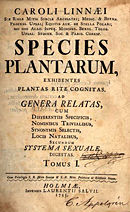
Spice trade
Civilizations of Asia were involved in spice trade from the ancient times, and the Greco-Roman world soon followed by trading along the Incense route and the Roman-India routes...
had a long history in trade, and there are good records of cultivar distribution by the Romans, European botanical and horticultural exploration rapidly increased in the 19th century with the colonial expansion taking place at the time. New plants were brought back to Europe while, at the same time, valuable economic plants, including those from the tropics, were distributed among the colonies. This plant trade has provided the common global heritage of economic and ornamental cultigens that we use today and which formed the stock for modern plant selection, breeding, and genetic engineering.
The plant exchange that occurred as a result of European trade can be divided into several phases:
-
-
-
- to 1560 mostly within Europe
- 1560–1620 Near East (esp. bulbous plants from Turkey – “tulipomania”)
- 1620–1686 Canada and Virginia herbaceous plants
- 1687–1772 Cape of South Africa
- 1687–1772 North American trees and shrubs
- 1772–1820 Australia, Tasmania, New Zealand
- 1820–1900 Tropical glasshouse plants; hardy Japanese plants
- 1900–1930 West China
- 1930 Intensive breeding and selection programs
-
-
1900 to 1950 – the Botanical Code and cultigen nomenclature
As the community of people dealing with the cultigens of commerce grew so, once again, the divergence between taxonomy serving scientific purposes and utilitarian taxonomy meeting human needs re-emerged. In 1865 German botanist Karl KochKarl Koch (botanist)
Karl Heinrich Emil Koch was a German botanist. He is best known for his botanical explorations in the Caucasus region, including northeast Turkey. Unfortunately, most of his collections have today been lost. He is also known as the first professional horticultural officer in...
, who became General Secretary of the Berlin Horticultural Society, expressed resentment at the continued use of Latin for cultigen names. Many proposals to deal with this were made, perhaps the most prominent being the Lois de la nomenclature botanique submitted in 1867 to the fourth Horticultural and Botanical Congress by Swiss botanist Alphonse de Candolle who, in Article 40 stated:
“Seedlings, half-breeds (métis) of unknown origin or sports should receive from horticulturists fancy names (noms de fantaisie) in common language, as distinct as possible from the Latin names of species or varieties.”

International Botanical Congress
International Botanical Congress is a large-scale meeting of botanists in all scientific fields, from all over the world. Authorized by the International Association of Botanical and Mycological Societies , congresses are held every six years with the venue circulating around the world. The XVIII...
and in 1905 at the second Congress in Vienna an agreed set of nomenclatural rules was established, the Vienna Rules, which became known from then on as the International Code of Botanical Nomenclature. After World War II the responsibility for the Botanical Code was taken up by the International Association for Plant Taxonomy
International Association for Plant Taxonomy
The International Association for Plant Taxonomy promotes an understanding of plant biodiversity, facilitates international communication of research between botanists, and oversees matters of uniformity and stability in plant names . The IAPT was founded on July 18, 1950 at the Seventh...
and meetings to discuss revisions are held at six-yearly intervals, the latest being in 2005
In horticulture at this time there existed all the problems that had confronted botanists in the 19th century – a plethora of names of various length, written and published in many languages with much duplication. The period between 1867 and 1953 was an uneasy time in which American horticulturists and other groups in Europe, such as the specialist orchid community, made attempts to put order into this chaos within their particular group of interest and devising their own rules for naming the plants of commerce.
Friedrich Alefeld
Friedrich Alefeld
Friedrich Georg Christoph Alefeld was a botanist, author and medical practitioner. Born in Weiterstadt-Gräfenhausen, Grand Duchy of Hesse, he described a number of plant species in his published works, taking a particular interest in legumes and malvaceae...
(1820–1872), who used Latin variety names, in a monographic study of beans, lentils and other legumes distinguished three infraspecific
Subspecies
Subspecies in biological classification, is either a taxonomic rank subordinate to species, ora taxonomic unit in that rank . A subspecies cannot be recognized in isolation: a species will either be recognized as having no subspecies at all or two or more, never just one...
taxonomic categories: Uterart (subspecies), Varietaten Gruppe and Kultur-Varietat, all with Latin names. In doing this he was probably laying the ground for the later establishment of the cultigen classification categories cultivar and Group. In conjunction with the Brussels International Botanical Congress of 1910 there was an International Horticultural Congress having a horticultural nomenclature component.
As a result of general dissatisfaction and a submission from the Royal Horticultural Society
Royal Horticultural Society
The Royal Horticultural Society was founded in 1804 in London, England as the Horticultural Society of London, and gained its present name in a Royal Charter granted in 1861 by Prince Albert...
the Règles de Nomenclature Horticole was established. The use of simple descriptive Latin names (e.g. compactus, nanus, prostratus) for horticultural variants was accepted and so too were names in the local language – which were not to be translated and should preferably consist of one word and a maximum of three. This first Horticultural Code consisted of 16 Articles. With the intercession of a World War I it was not until the 9th Horticultural Congress in London in 1930 that the rules of a Horticulture Nomenclature Committee were agreed and added as an appendix to the 1935 Botanical Code. The rules established in 1935 were accepted but needed to be extended to include the cultigens of agriculture and forestry, but it was only a result of discussions at the 1950 International Botanical Congress in Stockholm and the 18th International Horticultural Congress in London in 1952 the first International Code of Nomenclature for Cultivated Plants was published in 1953. The American horticultural botanist Liberty Hyde Bailey
Liberty Hyde Bailey
Liberty Hyde Bailey was an American horticulturist, botanist and cofounder of the American Society for Horticultural Science.-Biography:...
was responsible for coining the word cultigen in 1918
and cultivar in 1923, the word cultivar only coming into general circulation with the new Code of 1953. The use of these two terms belies the multitude of classification terms and categories that had been suggested as designations for cultigens.
1953 – the International Code of Nomenclature for Cultivated Plants
The first Cultivated Plant Code (Wageningen), which was published in 1953, has been followed by eight subsequent editions – in 1958 (Utrecht), 1961 (update of 1958), 1969 (Edinburgh), 1980 (Seattle), 1995 (Edinburgh), 2004 (Toronto) and 2009 (Wageningen).Following the structure of the Botanical Code the Cultivated Plant Code is set out in the form of an initial set of Principles followed by Rules and Recommendations that are subdivided into Articles. Amendments to the Cultivated Plant Code are prompted by international symposia for cultivated plant taxonomy which allow for rulings made by the International Commission on the Nomenclature of Cultivated Plants. Each new Cultivated Plant Code includes a summary of the changes made to the previous version and these have also been summarised for the period 1953 to 1995.
International Association for Cultivated Plant Taxonomy
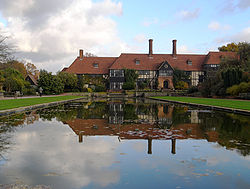
Presenting cultigen names
Most cultigens have names consisting of a Latin name that is governed by the International Code of Botanical Nomenclature e.g. Malus domestica, to which is added a cultigen epithet, enclosed in single quotes e.g. Malus domestica ‘Granny Smith’. The formation and use of the three classification categories (ranks) used for cultigens, the cultivar, Group and grex, is regulated by the Cultivated Plant Code. Examples of acceptable ways to present cultigen names are given below:-
-
- Prunus serrata Sato-zakura Group
- Prunus serrata (Sato-zakura Group) ‘Ojochin’
- Prunus ‘Ojochin’
- Flowering cherry ‘Ojochin’
-
Contemporary issues in cultivated plant taxonomy
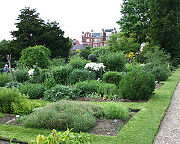
Germplasm
A germplasm is a collection of genetic resources for an organism. For plants, the germplasm may be stored as a seed collection or, for trees, in a nursery.-See also:*Germ plasm, the germ cell determining zone...
collections of cultivars, including herbaria; the recording and registration of cultivars.
The ways in which the plant variation resulting from human activity is named and classified remains contentious. The replacement of the expression “cultivated plant” with the word “cultigen” is not universally accepted. The debate continues concerning the notions of ranks and taxa as applied to cultigens. Is it appropriate to call the highly modified transgenic products
Transgene
A transgene is a gene or genetic material that has been transferred naturally or by any of a number of genetic engineering techniques from one organism to another....
of human artificial selection “taxa” in the same way we do for the products of natural selection in the wild? To overcome this difficulty the term culton (pl. culta) has been suggested to replace the word taxon when speaking about cultigens.
Then, most “wild” plants fit neatly into the nested hierarchy of ranks used in Linnaean classification (species into genera, genera into families etc.) which aligns with Darwinian descent with modification. Choosing classification categories for cultigens is not clear-cut. Included among cultigens are: simple selections taken from plants in the wild or in cultivation; artificial hybrids produced both by accident and intention; plants produced by genetic engineering
Genetic engineering
Genetic engineering, also called genetic modification, is the direct human manipulation of an organism's genome using modern DNA technology. It involves the introduction of foreign DNA or synthetic genes into the organism of interest...
; clonal material
Cloning
Cloning in biology is the process of producing similar populations of genetically identical individuals that occurs in nature when organisms such as bacteria, insects or plants reproduce asexually. Cloning in biotechnology refers to processes used to create copies of DNA fragments , cells , or...
reproduced by cuttings, grafting
Grafting
Grafting is a horticultural technique whereby tissues from one plant are inserted into those of another so that the two sets of vascular tissues may join together. This vascular joining is called inosculation...
, budding
Budding
Budding is a form of asexual reproduction in which a new organism grows on another one. The new organism remains attached as it grows, separating from the parent organism only when it is mature. Since the reproduction is asexual, the newly created organism is a clone and is genetically identical...
, layering
Layering
Layering is a means of plant propagation in which a portion of an aerial stem grows roots while still attached to the parent plant and then detaches as an independent plant. Layering has evolved as a common means of vegetative propagation of numerous species in natural environments...
etc.; graft-chimaera
Graft-chimaera
In horticulture, a graft-chimaera may arise in grafting at the point of contact between rootstock and scion and will have properties intermediate to those of its "parents". A graft-chimaera is not a true hybrid but a mixture of cells, each with the genotype of one of its "parents": it is a chimaera...
s; selections from the wild; ancient selections of crops that date back thousands of years; selections of aberrant growth such as witches brooms; the results of deliberate repeatable single crosses between two pure lines to produce plants of a particular general appearance that is desirable for horticulture, but which are not genetically identical. The question remains as to whether the classification categories of cultivar, Group and grex are the most appropriate and efficient way to deal with this broad range of plant variation.
See also
- Domestication of plants
- Horticultural botanyHorticultural botanyHorticultural botany is the study of the botany of current and potential cultivated plants, with emphasis on the ornamental plants of horticulture, by a horticultural botanist or plantsman—plantsperson."-Horticultural botanists:...
- List of florilegia and botanical codices

